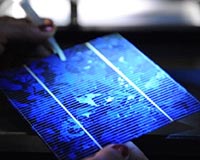 |
Zurich, Switzerland (SPX) Apr 25, 2011 Conventional silicon-based rigid solar cells generally found on the market are not suitable for manufacturing moldable thin-film solar cells, in which a transparent, flexible and electrically conductive electrode collects the light and carries away the current. A woven polymer electrode developed by Empa has now produced first results which are very promising, indicating that the new material may be a substitute for indium tin oxide coatings. The scarcity of raw materials and increasing usage of rare metals is making electronic components and devices more and more costly. Such rare metals are used, for example, to make the transparent electrodes found in mobile phone touchscreen displays, liquid-crystal displays, organic LEDs and thin-film solar cells. The material of choice in these cases is indium tin oxide (ITO), a largely transparent mixed oxide. Because ITO is relatively expensive, however, it is uneconomic to use in large area applications such as solar cells.
The search for alternatives The search for alternative coatings which are both transparent and electrically conductive is therefore intense, with materials such as conductive polymers, carbon nanotubes or graphenes coming under scrutiny. Carbon-based electrodes, however, generally show excessive surface resistance values which make them poor electrical conductors. If a metallic grid is integrated into the organic layer, it reduces not just its resistance but also its mechanical stability. If a solar cell made out of this material is bent, the electrode layers break and are no longer conductive. The challenge thus consists of manufacturing flexible yet stable conductive substrates, ideally in a cost-effective industrial rolling process.
One solution: woven electrodes Metal wires woven into the material ensure that it is electrically conductive. In a second process step the material is embedded in an inert plastic layer which does not, however, completely cover the metal filaments, thus retaining its conductivity. The electrode which results is transparent, stable and yet flexible. The Empa researchers then applied a series of coatings to this new substrate to create a novel organic solar cell whose efficiency is compatible to conventional ITO-based cells. In addition, the woven electrode is significantly more stable when deformed than commercially available flexible plastic substrates to which a thin layer of conductive ITO has been applied. Literature reference: William Kylberg, Fernando Araujo de Castro, Peter Chabrecek, Uriel Sonderegger, Bryan Tsu-Te Chu, Frank Nuesch and Roland Hany: Woven Electrodes for Flexible Organic Photovoltaic Cells, Adv. Mater. 2011, 23, 1015-1019, doi: 10.1002/adma.201003391
Share This Article With Planet Earth
Related Links Woven Electrodes for Flexible Organic Photovoltaic Cells, Adv. Mater. All About Solar Energy at SolarDaily.com
 Solar power without solar cells
Solar power without solar cellsAnn Arbor MI (SPX) Apr 25, 2011 A dramatic and surprising magnetic effect of light discovered by University of Michigan researchers could lead to solar power without traditional semiconductor-based solar cells. The researchers found a way to make an "optical battery," said Stephen Rand, a professor in the departments of Electrical Engineering and Computer Science, Physics and Applied Physics. In the process, they overtur ... read more |
|
| The content herein, unless otherwise known to be public domain, are Copyright 1995-2010 - SpaceDaily. AFP and UPI Wire Stories are copyright Agence France-Presse and United Press International. ESA Portal Reports are copyright European Space Agency. All NASA sourced material is public domain. Additional copyrights may apply in whole or part to other bona fide parties. Advertising does not imply endorsement,agreement or approval of any opinions, statements or information provided by SpaceDaily on any Web page published or hosted by SpaceDaily. Privacy Statement |